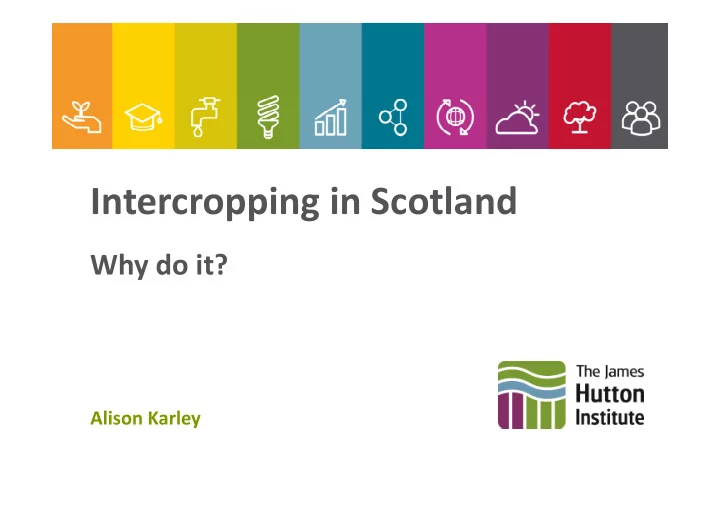

Intercropping in Scotland Why do it? Alison Karley
Intercropping research in Scotland Funded by: The Scottish Government’s Rural and Environment Science and Analytical Services Division The EU via the Horizon2020 Research and Innovation programme
What is intercropping? The practice of cropping two or more crops in close proximity Intercropping takes many forms and exploits the outcomes of beneficial interactions between diverse crop types Often the approach combines legumes and non‐legumes (e.g. cereals) A key aim of intercropping is to achieve yields greater than the monocrop, and with fewer inputs
Why intercrop? Increasing crop diversity can allow: Higher crop productivity More efficient use of resources Weed, pest and disease suppression Attract beneficial organisms Improve soil quality Resilience to stress Economic and environmental benefits: Lower input costs (fertilisers, pesticides) Reduced input losses to water, soil, air Enhanced ‘ecosystem services’
Designing InnoVative plant teams for Ecosystem Resilience and agricultural Sustainability The overall goal is to develop a novel system for sustainable food production by optimising crop species mixtures or ‘plant teams’ to improve yield stability, reduce pest and disease damage, and enhance stress resilience. Focussing on cereal‐legume plant teams and species‐rich grassland DIVERSify will • Identify novel crop/crop variety combinations • Develop new knowledge and tools to develop suitable cultivars • Devise agronomic specifications for novel cropping systems
‘Crop diversification’ cluster of Horizon2020 funded EU projects SFS‐02‐2016: Teaming up for good : Exploiting the benefits of species diversity in cropping systems SFS‐26‐2016: Legumes ‐ transition paths to sustainable legume‐based farming systems and agri‐feed and food chains RUR‐06‐2016: Crop diversification systems for the delivery of food, feed, industrial products and ecosystems services – from farm benefits to value‐chain organisation
Scottish Government funded projects Workpackage 2.1 Crop and grassland production and disease control Novel crops : designing alternative legume and non‐legume intercrops Workpackage 2.3 Agricultural systems Alternative approaches to sustainable land management : effects of alternative cropping systems on nutrient management, biodiversity and ecosystem services
Multiple actors and innovators Define the ideal plant partners and practices for the best‐performing intercrops or ‘plant teams’ Practitioners Scientists Existing knowledge of Experimental validation of innovative practitioners scientific theory
Field lab: what is the benefit? Stakeholder consultation DIVERSify, ReMIX Participatory Farmer Data collection and trials trial evaluation EU projects, Field Lab Scientific trials Hutton, SRUC
Stakeholder consultation 15 National Stakeholder Workshops in 11 different countries The aim of each workshop was to identify: Best practice examples Barriers to the take‐up of plant teams Plant teams and research topics for scientific trials
Who attended
Plant teams identified • Attendees identified nearly 130 different plant team combinations (two or more crops): 71 with cereals as the main crop 17 with pseudo grains as the main crop 5 forage/grass 22 vegetable systems 14 Agroforestry and other
Barriers to plant team uptake
Field lab: what is the benefit? Stakeholder consultation DIVERSify, ReMIX Participatory Farmer Data collection and trials trial evaluation EU projects, Field Lab Scientific trials Hutton, SRUC
Field lab aims What types of intercrops are relevant to you? What information do you need to select intercrop species? What are the practical considerations? What solutions exist to overcome hurdles? Provide support and advice through the crop growing cycle
Recommend
More recommend